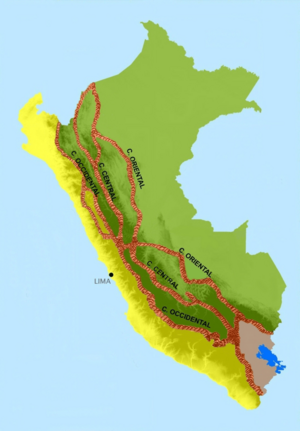Cordillera Occidental (Peru) facts for kids
The Cordillera Occidental is a huge mountain range in Peru. It's like the western arm of the mighty Andes mountains, which stretch across South America. This range forms a natural border on Peru's western side. It either meets the flat coastal areas or drops steeply into the Pacific Ocean with tall cliffs.
To the east of the Cordillera Occidental, you'll find two other important Peruvian mountain ranges: the Cordillera Central and the Cordillera Oriental. All these ranges are part of the Andes, showing how the Earth's crust has been pushed up over millions of years to form these giant mountains. This process is called an "orogeny," which means mountain building.
Contents
What is the Cordillera Occidental?
The Cordillera Occidental is the longest and highest of Peru's three main mountain chains. It runs from the northern part of Peru all the way to the south. These mountains are very important for Peru's climate and rivers. They act like a big wall, blocking moisture from the Pacific Ocean.
How were these mountains formed?
These mountains were formed by a process called the Andean orogeny. This happened when the Nazca tectonic plate, which is under the Pacific Ocean, slowly slid underneath the South American plate. When these two giant pieces of the Earth's crust crashed into each other, the land on the South American plate was pushed up and folded. This created the towering peaks and deep valleys we see today in the Andes. It's a process that has been going on for millions of years and is still happening!
Geography and Climate
The Cordillera Occidental is known for its very high peaks. Many of them are over 6,000 meters (about 19,700 feet) tall. The highest point in the range is Mount Huascarán, which is also the highest mountain in Peru. These high altitudes mean the climate can be very cold, with snow and glaciers on the highest peaks.
Rivers and water sources
Many important rivers in Peru start in the Cordillera Occidental. The melting snow and ice from the glaciers feed these rivers. These rivers then flow down to the coast or into the Amazon basin. They provide water for farming, drinking, and generating electricity for many Peruvian cities and towns. The water from these mountains is vital for life in Peru.
Wildlife and Plants
Even though the Cordillera Occidental is a harsh environment, it is home to many unique animals and plants. You can find animals like the vicuña, which is related to the llama, and the majestic Andean condor, one of the largest flying birds in the world.
Unique ecosystems
The different altitudes in the Cordillera Occidental create various ecosystems. At lower elevations, you might find dry forests or scrublands. As you go higher, you'll see grasslands called "puna" and then rocky, icy landscapes near the peaks. Each of these zones has its own special types of plants and animals that have adapted to the conditions.
Human Impact and Importance
People have lived in the Cordillera Occidental for thousands of years. Ancient civilizations, like the Inca Empire, built cities and farms in these mountains. Today, many communities still live in the valleys and slopes of the range. They often rely on farming, mining, and tourism.
Mining and resources
The Cordillera Occidental is rich in minerals. There are many mines in the region that extract valuable resources like copper, gold, and silver. These mines are important for Peru's economy. However, mining also brings challenges, such as protecting the environment and ensuring the well-being of local communities.
Tourism and adventure
The stunning landscapes of the Cordillera Occidental attract many tourists and adventurers. People come to hike, climb mountains, and explore the natural beauty. National parks and protected areas help preserve these unique environments and offer opportunities for people to enjoy the mountains responsibly.
See also
 In Spanish: Cordillera Occidental (Perú) para niños
In Spanish: Cordillera Occidental (Perú) para niños


